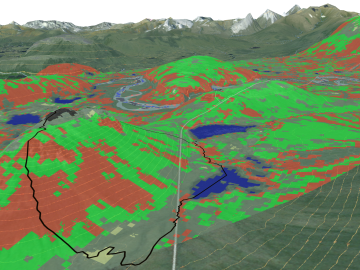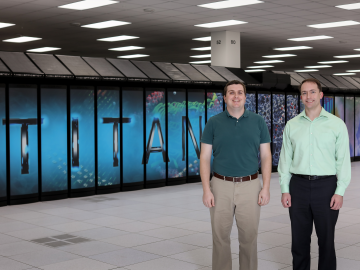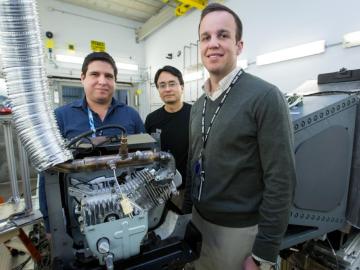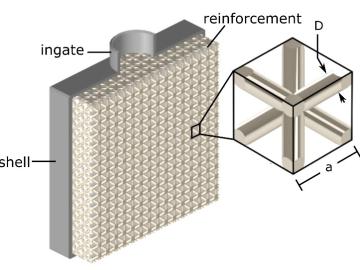
Filter News
Area of Research
- (-) Energy Science (139)
- (-) National Security (29)
- (-) Supercomputing (98)
- Advanced Manufacturing (10)
- Biology and Environment (127)
- Biology and Soft Matter (1)
- Building Technologies (2)
- Computational Biology (2)
- Computational Engineering (3)
- Computer Science (10)
- Electricity and Smart Grid (1)
- Energy Sciences (1)
- Functional Materials for Energy (1)
- Fusion and Fission (7)
- Fusion Energy (1)
- Isotopes (1)
- Materials (72)
- Materials for Computing (10)
- Mathematics (1)
- Neutron Science (127)
- Nuclear Science and Technology (6)
- Quantum information Science (1)
News Topics
- (-) Artificial Intelligence (50)
- (-) Composites (17)
- (-) Environment (73)
- (-) Machine Learning (28)
- (-) Mercury (3)
- (-) Neutron Science (22)
- (-) Summit (44)
- 3-D Printing/Advanced Manufacturing (83)
- Advanced Reactors (8)
- Big Data (30)
- Bioenergy (31)
- Biology (22)
- Biomedical (22)
- Biotechnology (7)
- Buildings (39)
- Chemical Sciences (16)
- Clean Water (8)
- Computer Science (116)
- Coronavirus (27)
- Critical Materials (12)
- Cybersecurity (28)
- Energy Storage (74)
- Exascale Computing (27)
- Fossil Energy (2)
- Frontier (32)
- Fusion (3)
- Grid (45)
- High-Performance Computing (46)
- Hydropower (3)
- Isotopes (2)
- Materials (46)
- Materials Science (41)
- Mathematics (4)
- Microelectronics (1)
- Microscopy (14)
- Molten Salt (1)
- Nanotechnology (15)
- National Security (38)
- Nuclear Energy (14)
- Partnerships (16)
- Physics (9)
- Polymers (13)
- Quantum Computing (20)
- Quantum Science (27)
- Security (18)
- Simulation (18)
- Software (1)
- Space Exploration (6)
- Statistics (1)
- Transportation (72)
Media Contacts

A team of scientists led by Oak Ridge National Laboratory used machine learning methods to generate a high-resolution map of vegetation growing in the remote reaches of the Alaskan tundra.

Oak Ridge National Laboratory scientists studying fuel cells as a potential alternative to internal combustion engines used sophisticated electron microscopy to investigate the benefits of replacing high-cost platinum with a lower cost, carbon-nitrogen-manganese-based catalyst.
Scientists studying a valuable, but vulnerable, species of poplar have identified the genetic mechanism responsible for the species’ inability to resist a pervasive and deadly disease. Their finding, published in the Proceedings of the National Academy of Sciences, could lead to more successful hybrid poplar varieties for increased biofuels and forestry production and protect native trees against infection.

Biologists from Oak Ridge National Laboratory and the Smithsonian Environmental Research Center have confirmed that microorganisms called methanogens can transform mercury into the neurotoxin methylmercury with varying efficiency across species.

The US Department of Energy’s Oak Ridge National Laboratory is once again officially home to the fastest supercomputer in the world, according to the TOP500 List, a semiannual ranking of the world’s fastest computing systems.

The U.S. Department of Energy’s Oak Ridge National Laboratory today unveiled Summit as the world’s most powerful and smartest scientific supercomputer.

A team of researchers from the Department of Energy’s Oak Ridge National Laboratory has married artificial intelligence and high-performance computing to achieve a peak speed of 20 petaflops in the generation and training of deep learning networks on the

The field of “Big Data” has exploded in the blink of an eye, growing exponentially into almost every branch of science in just a few decades. Sectors such as energy, manufacturing, healthcare and many others depend on scalable data processing and analysis for continued in...

Researchers used neutrons to probe a running engine at ORNL’s Spallation Neutron Source

A new manufacturing method created by Oak Ridge National Laboratory and Rice University combines 3D printing with traditional casting to produce damage-tolerant components composed of multiple materials. Composite components made by pouring an aluminum alloy over a printed steel lattice showed an order of magnitude greater damage tolerance than aluminum alone.


